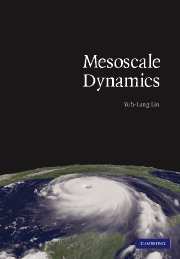Book contents
- Frontmatter
- Contents
- Preface
- 1 Overview
- 2 Governing equations for mesoscale motions
- 3 Basic wave dynamics
- 4 Mesoscale wave generation and maintenance
- 5 Orographically forced flows
- 6 Thermally forced flows
- 7 Mesoscale instabilities
- 8 Isolated convective storms
- 9 Mesoscale convective systems
- 10 Dynamics of fronts and jet streaks
- 11 Dynamics of orographic precipitation
- 12 Basic numerical methods
- 13 Numerical modeling of geophysical fluid systems
- 14 Parameterizations of physical processes
- Appendices
- Index
- References
14 - Parameterizations of physical processes
Published online by Cambridge University Press: 15 December 2009
- Frontmatter
- Contents
- Preface
- 1 Overview
- 2 Governing equations for mesoscale motions
- 3 Basic wave dynamics
- 4 Mesoscale wave generation and maintenance
- 5 Orographically forced flows
- 6 Thermally forced flows
- 7 Mesoscale instabilities
- 8 Isolated convective storms
- 9 Mesoscale convective systems
- 10 Dynamics of fronts and jet streaks
- 11 Dynamics of orographic precipitation
- 12 Basic numerical methods
- 13 Numerical modeling of geophysical fluid systems
- 14 Parameterizations of physical processes
- Appendices
- Index
- References
Summary
Reynolds averaging
In the previous two chapters, we have described numerical methods for approximating the primitive equations and the setup for numerical models, such as grid systems, and initial and boundary conditions. As demonstrated in Section 13.5, a mesoscale model may be developed to simulate a simple geophysical fluid system, such as a stratified, inviscid flow over topography. However, in order to apply this type of geophysical fluid dynamics model to simulate mesoscale atmospheric phenomena, some important physical processes, such as boundary layer processes, moist processes, and radiative transfer processes, need to be represented or parameterized in the model.
In order to numerically integrate the governing differential equations in a limited area, a numerical method, such as a finite difference method, spectral method or finite element method, must be used to approximately represent the atmospheric motion and processes by the dependent variables at grid points or elements. The approximations limit the explicit representation of atmospheric motions and processes to a scale smaller than that for the grid interval, truncated wavelength, or finite element. For example, large-scale disturbances may cascade down to mesoscale, then further down to the smallest turbulent eddies responsible for viscous dissipation in the atmosphere. If the subgrid-scale disturbances are not appropriately represented by the grid point values, they may cause nonlinear aliasing and nonlinear numerical instability, as discussed in Chapter 13.
- Type
- Chapter
- Information
- Mesoscale Dynamics , pp. 563 - 609Publisher: Cambridge University PressPrint publication year: 2007



